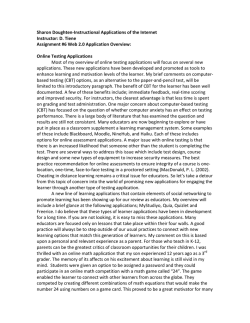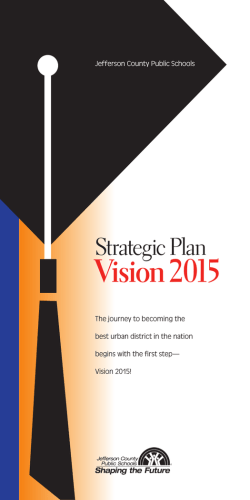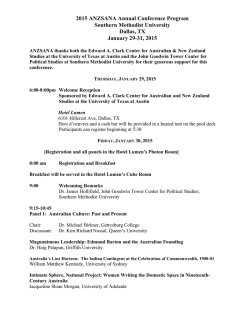
Exploring the role and skill set of physiotherapy clinical educators in
Exploring the role and skill set of physiotherapy clinical educators in work-integrated learning SUSAN EDGAR 1 JOANNE CONNAUGHTON The University of Notre Dame Australia, Fremantle, Australia Clinical educators are under increasing pressures in the workplace to provide quality education of healthcare students within varying supervision frameworks. Along with facilitating the teaching of clinical skills, clinical educators play a support role for students and so require more than expert clinical abilities in their vital position linking institutions and the healthcare environment. Twelve physiotherapy clinical educators attended one of two focus groups exploring their opinions on the role and skill set of clinical educators in work-integrated learning (WIL). Clinical educators described their role, their skills, challenges they faced supporting the needs of students, as well as future training requirements. The focus group results highlighted the important role of soft skills in the clinical educator role. The development of this skill set is essential to ensure quality supervision through optimal interactions between clinical educators and students in WIL. (Asia-Pacific Journal of Cooperative Education, 2014, 15(1), 29-36) Keywords: Clinical educator; co-operative learning; work-integrated learning (WIL) Clinical educators offer an important link between the institution and healthcare environment by providing supervision of students undertaking work -integrated learning (WIL). In healthcare, clinical educators are utilized in medicine, nursing and allied health education and work under varying frameworks dependent on both the workplace and institutional model. Educators may be clinicians employed by industry or by the educational institution. They typically have the responsibility for graded or competency-based assessment of students’ knowledge and skills, as well as the development of professional workplace skills. Despite the varied role of the clinical educator, Radke and McArt (1993) suggested that it is not appropriate to simply add the role of educator to that of clinician. Their study reviewed the position of the nurse educator and highlighted the broad skill set requirements necessary to carry out this role. Cross (1995) looked at identifying what made a ‘good’ physiotherapy clinical educator through ranking of likely descriptors from all stakeholders, including students, clinical educators and academic staff. Students ranked ‘approachable’ and ‘good communicator’ as their highest preferred descriptors, followed by ‘knowledgeable’. Of note, clinical educators placed ‘good role model’ as their highest in mean rank order with ‘knowledgeable’ coming in at number five. The university academics’ ranked list had the greatest point of difference with ‘interested in the learning process’ and ‘concerned about patient care’ ranked in their top three after ‘good communicator’. Despite this lack of clarity on the ideal characteristics of a clinical educator, there has been limited literature since Cross’s study on the skills or features that make up a good clinical educator. However, the ‘supervisory relationship’ has been identified as one of the most important elements of a quality clinical learning environment (Saarikoski & Leino-Kilpi, 2002). Nursing students reported that the impact of their interactions with their clinical educator was just as great as the impact of dealing with patients, in their first acute nursing placement (James & Chapman, 2009). Recommendations from the 2012 Final Report on promoting quality clinical placements, commissioned by Health Workforce Australia, recognized that effective student supervision was facilitated through 1 Corresponding author: Susan Edgar, [email protected] EDGAR, CONNAUGHTON: The role and skill set of physiotherapy educators ‘supervisor characteristics’ alongside appropriate supervisor development (Siggins Miller Consultants, 2012). Identifying these characteristics will go some way towards enabling appropriate education and support of clinical educators in WIL. Increasing demand for the provision of student training in healthcare, due to rising placement numbers (McMeeken, Grant, Webb, Krause, & Garnett, 2008), is placing an increased demand on both the numbers and training of clinical educators. With this increasing demand for placements, along with competing interests of educational institutions for clinical placements, come potentially added stresses to the role undertaken by clinical educators. In physiotherapy and other healthcare professions there are several models of supervision practice and assessment in WIL (Dean et al., 2009). Clinical educators may supervise in a one-to-one model, peer assisted learning (PAL) model or facilitate small group supervision and learning. The School of Physiotherapy at The University of Notre Dame Australia (Notre Dame) adopts a one-to-one clinical educator model for clinical placements, with university employed clinical educators supporting facility supervisors (clinicians) by providing three hours of supervision per week for four out of the five weeks of the clinical placement block. Not all placements request a clinical educator, however clinical educators are utilized in 100% of tertiary hospital placements. Where two students are at the same placement, clinical educators may instigate a PAL framework, thereby providing six hours of supervision for two students concurrently. Clinical educators work closely with facility supervisors to monitor the students’ progress through their clinical placement and provide written feedback at the mid and end placement. They are not, however, responsible for the student’s final assessment and grading for the placement. The aim of this study was to explore the role and skill set of the physiotherapy clinical educator in the one-to-one model and PAL model of clinical supervision in WIL. Previous research has not been conducted on the perceptions and expectations of clinical educators in the institutional model of WIL. A qualitative approach was taken to explore the descriptive elements of the clinical educator role and investigate attitudes towards the topics and issues presented. Findings from this study will direct educational focus for clinical education training programs, leading to improved support of clinical educators in the workplace. METHODS The study participants were Notre Dame clinical educators currently employed by the School of Physiotherapy to provide supervision of students on clinical placements. Ethics approval was gained from the Human Research Ethics Committee of The University of Notre Dame Australia (Reference number: 012108F). Twenty clinical educators were contacted by email and invited to attend one of two focus groups on campus. Twelve clinical educators responded and two focus groups were run with six participants in each session. Participants provided informed consent for the study and were offered no monetary incentive to attend the focus groups. Each focus group was facilitated by a member of the School of Physiotherapy Clinical Education Team with a second member present to record and scribe. Each session was audio-recorded and transcribed verbatim following completion, with validation of the script by both team members. The focus groups followed a semi-structured format with pre-set questions as well as the opportunity for open-ended discussion. Following transcription, Asia-Pacific Journal of Cooperative Education, 2014, 15(1), 29-36 30 EDGAR, CONNAUGHTON: The role and skill set of physiotherapy educators data from each focus group was manually coded by the researchers into concepts and further into relevant categories of data, with stages of analysis conducted as recommended by Braun and Clarke (2006). Topics and issues explored at each focus group included: the role of the university clinical educator; skill requirements to fulfill the role; identification of difficult or challenging situations and strategies for management of these situations; support needs of students; and further training requirements for clinical educators as a result of the skills and needs identified. An overview of the discussion and main themes explored in both groups is presented in the results. In reporting the findings, qualitative data were reported if consensus was reached on an issue by at least half the members of each focus group. Individual quotes are representative of the themes identified within these discussion threads. RESULTS Role of the Clinical Educator Each focus group commenced with a discussion on the role of the clinical educator in WIL and both groups presented and explored similar findings. Of interest, no attendees raised education or clinical teaching and learning in the initial discussion thread on their role as a clinical educator. Instead, educators from both groups presented their role as providing support, guidance and mentoring. Likewise, advocating for the student in their position representing the university was also recognized as an essential aspect of their role, by one focus group. One opening observation was that “we need to encourage them to step in and actually be a therapist as they are hanging back and being a student….so it’s encouraging them to step forwards and use the skills that they already have”. Similarly, one clinical educator commented “it’s a mentoring role in terms of giving guidance to students and where their strengths are and where their weaknesses are”. Likewise, another clinical educator further described their role as “…a sounding block for students”. Clinical educators emphasized their important position as “…advocate for the student”, further commenting that “…you need to be a liaison person between the student and the facility supervisor and between the university as well”. One clinical educator commented that “...we’re here to help those students get through whatever they need to do to get through”. Clinical educators from one focus group identified that part of their role was providing “... a safe environment” for students. Within that environment it was acknowledged that students could then feel comfortable to ask questions as well as gain an understanding of skills from “...a different perspective or background”. One clinical educator voiced that having a different educational background or training to the student allowed them to “...provide a different angle on something they may not have understood”. “Teaching as well” was only identified towards the end of the discussion thread in one focus group, as part of the role of the clinical educator. This highlighted the decreased emphasis on this aspect of the clinical educator role in this model of WIL. Asia-Pacific Journal of Cooperative Education, 2014, 15(1), 29-36 31 EDGAR, CONNAUGHTON: The role and skill set of physiotherapy educators Skills Clinical educators discussed the necessity of a broad skill set requirement to fulfill their role in the WIL environment. They emphasized the skills of mediation and diplomacy as important for their role in being an advocate for the student. Dealing with “...conflicting feedback” from multiple clinical supervisors in the workplace was raised in one focus group with participants acknowledging that they required good communication and listening skills to liaise with not only students but other staff in the clinical setting. One clinical educator noted that “within the same facility, I’ve found that different supervisors have different ways that they want things done and that’s been an issue with the students” with another educator adding “you have to be very diplomatic”. Versatility with the ability to know how to teach in a variety of styles was acknowledged as an important skill in the clinical educator role with one participant noting “...the biggest thing I’ve learnt over the time is knowing how to adjust my teaching style for each student, knowing how they react to how I’m teaching it”. Taking this further, another clinical educator acknowledged that you have to be adaptable to other concepts and ideas and through this impart in students the ability to “...respect your peer clinicians”. Discussions on versatility and adaptability, although initially linked to teaching and learning styles, concluded with further focus on the need for diplomacy in the WIL environment, where there may be several methods of achieving a similar clinical outcome. One participant highlighted the need for professional skills commenting that “I think there’s a lot of professionalism that comes in there because you might not agree with that ...so you have to really just take it on and be professional”. Excellent communication and listening skills were raised by both focus groups, as essential skills required in the clinical educator role. One participant noted I think it comes back to being that sounding block... It perhaps feeds back into the skills that you need to provide them with the link between uni and clinical. Sitting and hearing their story and asking them what’s going on? It can hinder them a bit if they’re really anxious and stressing out. Skills in “...just being patient and a good listener” were also raised, as was the ability to ”...read the student ”. Good communication skills were deemed particularly essential when clinical educators utilized the PAL model with one clinical educator noting that success depended ..on the student mix. So you get a pair where one is dominant and one tends to sit back and let it all happen. So I guess if you see that happening in the first week then you discourage too much of that in future weeks. Another clinical educator noted that the quieter student needs encouraging “...or you let them take the lead of one patient”, emphasizing the role of mentor and advocate within this supervision model. Challenges and Strategies The discussions on challenges faced by clinical educators in the WIL environment centered on underperforming students. There was acknowledgement that reasons for underperforming could be “...a blend of clinical and outside-clinical issues”. One clinical educator noted that when managing students with difficulties “...it was almost like being a coordinator in that sense as well as helping the student...stepping up a bit more”. Leadership skills were required to manage the situation with another clinical educator noting that “you Asia-Pacific Journal of Cooperative Education, 2014, 15(1), 29-36 32 EDGAR, CONNAUGHTON: The role and skill set of physiotherapy educators need confidence because you are in a leadership role”. Liaison with the university was deemed important in this situation with one clinical educator reflecting “I think that’s what I found very supportive of the university supporting us because you know the students so well”. Likewise, another noted “the good thing for us is that you guys are there for support and you know who we are and you know the students as well”. Management of health or other personal issues required clinical educators to provide students with “...more support through the prac”, with one clinical educator discussing the initial difficulties with a student being “...closed off at the start but ...opened up” through the clinical placement. Maintaining motivation of students particularly following feedback sessions was highlighted by one clinical educator as an area where more guidance on strategies would be beneficial. The participant described students who “...haven’t reached their full potential so they haven’t done themselves a favor” with loss of motivation in the second half of their clinical placement. This left the clinical educator frustrated and feeling “...a bit inadequate“ with lower overall outcomes achieved by the students. Clinical educators voiced their support of the existing clinical educator workshops run by the institution and the role of these sessions in the facilitation of teaching and learning styles. They acknowledged that a greater connection to the university would be beneficial with one clinical educator commenting “I think it’s nice to have a connection with the university. To actually come down...and feel connected not just by phone or email”. A forum for collaboration between clinical educators was also recognized as a further strategy for support of clinical educators with one participant noting that “it’s also great sometimes to have the opportunity to meet up with other facility tutors as well. Sometimes you feel like you’re a bit alone so it provides the opportunity to do that as well”. The idea of providing a format similar to that of the focus group, was raised by one clinical educator as a useful debriefing and feedback platform for clinical educators in WIL. DISCUSSION The findings from this study confirm the broad skill set requirements desirable to supervise students in this model of WIL (Radke & McArt, 1993). The ability to fit into a clinical environment alongside clinical staff and students is imperative for university employed clinical educators. The clinical educators in this study emphasized the necessity of strong non-clinical skills or soft skills in discussions on their role, skill requirements and challenges. Of interest, the provision of soft skills training is becoming more prevalent in tertiary education curricula as universities promote these skills as essential personal skills linked to generic graduate attributes (Gonzalez, Abu Kasim, & Naimie, 2013). Soft skills included in dentistry undergraduate training to better prepare students for the workplace included communication skills, critical thinking and problem solving, teamwork, leadership, professional ethics and morals, lifelong learning and entrepreneurship (Gonzalez et al., 2013). Despite this increased emphasis on soft skill development for students in the higher education sector, clinical educators appear to be missing out with limited growth in the diversity of clinical education training, beyond clinical and educational skills. Mental health issues are becoming more prevalent among higher education students (Laws & Fiedler, 2012) and clinical educators in both focus groups raised their concerns regarding dealing with students in difficulty either due to clinical or external issues. Lee and French (1997) highlighted the need for nursing preceptors to have additional skills in providing emotional support to students. Similarly, Beck (1993) highlighted the ‘reality shock’ Asia-Pacific Journal of Cooperative Education, 2014, 15(1), 29-36 33 EDGAR, CONNAUGHTON: The role and skill set of physiotherapy educators encountered by nursing students on their first clinical placement and the resultant importance of appropriate dialogue between students and their educators. With an increased prevalence in mental health and emotional issues, it would seem appropriate to provide additional education within clinical educator training programs. Existing training programs typically teach communication skills within the educational context of questioning and providing feedback (Health Education and Training Institute, 2012) but what is less evident is the teaching of communication skills such as listening, diplomacy and mediation. Recognition of mental health conditions and appropriate education on their management would also be highly relevant to include in clinical educator training programs. Maintaining motivation of students in WIL was identified as a challenge, with students reportedly losing interest and engagement following feedback sessions. With a direct link between motivation and likelihood of success (Fortune, Lee, & Cavazos, 2005), this can lead to frustration with managing students in this position. Motivation studies (Martin, 2007, 2008) have highlighted that non-cognitive learner characteristics can affect student engagement, yet are not necessarily stable. Thus interactions between individuals and the educator/institution/learning environment can be altered to affect student motivation. Strategies on promoting motivation would be invaluable to include in training programs, equipping clinical educators with appropriate tools to allow students to maximize their learning experiences. Teamwork and leadership skills are rarely taught directly to clinical educators. However, with clinical educators emphasizing their role in WIL as liaising and advocating for students, this skill set can only be strengthened through the development of these soft skills. Power issues can exist between health and educational institutions around patient centered care and student learning outcomes. Leadership and teamwork skills can significantly influence the outcome, highlighting a need for these skill sets to be included in clinical educator training to facilitate the advocate role. Further, professional ethics and morals, including respect for others in the clinical supervision framework, are not explicitly taught in current clinical education training programs, though would be a useful inclusion. Clinical educators attending the focus groups voiced their appreciation of the opportunity to discuss and share issues of concern. They also acknowledged the value they place on their interactions with the institution and the support and training they provide. The focus groups themselves became a forum for problem-solving with comparisons made between strategies utilized for supervising and managing challenging situations. Regular forums in this manner to debrief, question and collaborate, may go some way to developing and extending the critical thinking and problem solving skills of clinical educators. Previous studies have acknowledged the importance of implementing training programs for educators (Hook & Lawson-Porter, 2003). However, in nursing and medicine where clinical educators are also utilized in professional training, it has been recognized that clinical supervision is one of the least researched and supported aspects of professional education (Bush, 2005; Kilminster, Cottrell, Grant, & Jolly, 2007). It is anticipated that information gained from this research will direct both future research and development of training resources and programs. The authors acknowledge the limitations of this study which include the small numbers of participants although sixty percent of currently employed clinical educators responded to the invite to attend the focus groups. Further, both focus groups resulted in similar discussion outcomes. The findings of this study cannot be generalized to all clinical educators in physiotherapy or to healthcare supervision in general. As previously noted, there are many Asia-Pacific Journal of Cooperative Education, 2014, 15(1), 29-36 34 EDGAR, CONNAUGHTON: The role and skill set of physiotherapy educators models of supervision and assessment for clinical placements and of particular note, Notre Dame clinical educators do not directly assess student physiotherapists in WIL. However, facilitating the assessment of students would only further add to the skill set required and the provision of soft skills training would potentially enhance the delivery of assessment findings. CONCLUSION This study explored the role and skill set requirements of clinical educators in WIL and revealed the necessity for soft skills training to complete their role. There is a paucity of literature on the provision of soft skills training for this population with institutions focusing on teaching and learning styles along with clinical skills. Further development of communication skills including listening, debriefing and mediation may assist clinical educators with managing conflict and challenging situations in the workplace. Provision of education on engaging and motivating students may contribute to facilitating optimal educational outcomes whilst improving student support. Forums for problem-based discussions as well as leadership and team building activities will allow further skill development to assist clinical educators in their guidance and mentoring role. These soft skills will enable clinical educators to facilitate quality clinical learning environments for students engaged in WIL. ACKNOWLEDGEMENTS The authors would like to thank the Notre Dame clinical educators who participated in this study. REFERENCES Beck, C. T. (1993). Nursing students’ initial clinical experience: A phenomenological study. International Journal of Nursing Studies, 30(6), 489-497. Braun, V., & Clarke, V. (2006). Using thematic analysis in psychology. Qualitative Research in Psychology, 3(2), 77-101. Bush, T. (2005). Overcoming the barriers to effective clinical supervision. Nursing Times, 101(2), 38-41. Cross, V. (1995). Perceptions of the ideal clinical educator in physiotherapy education. Physiotherapy, 81(9), 506-513. Dean, C. M., Stark, A. M., Gates, C. A., Czerniec, S. A., Hobbs, C. L., Bullock, L. D., & Kolodziej, I. I. (2009). A profile of physiotherapy clinical education. Australian Health Review, 33(1), 38-46. Fortune, A. E., Lee, M., & Cavazos, A. (2005). Achievement motivation and outcome in social work field education. Journal of Social Work Education, 41(1), 115-129. Gonzalez, M. A. G., Abu Kasim, N. H., & Naimie, Z. (2013). Soft skills and dental education. European Journal of Dental Education, 17(2), 73-82. Health Education and Training Institute. (2012). The superguide: A handbook for supervising allied health professionals. Sydney, NSW, Australia. Hook, A. D., & Lawson-Porter, A. (2003). The development and evaluation of a fieldwork educator's training programme for allied health professionals. Medical Teacher, 25(5), 527-536. James, A., & Chapman, Y. (2009). Preceptors and patients – the power of two: Nursing student experiences on their first acute clinical placement. Contemporary Nurse: A Journal for the Australian Nursing Profession, 34(1), 34-47. Kilminster, S, Cottrell, D., Grant, J., & Jolly, B. (2007). AMEE Guide No.27: Effective educational and clinical supervision. Medical Teacher, 29(1), 2-19. Laws, T. A., & Fiedler, B. A. (2012). Universities' expectations of pastoral care: Trends, stressors, resource gaps and support needs for teaching staff. Nurse Education Today, 32(7), 796-802. Asia-Pacific Journal of Cooperative Education, 2014, 15(1), 29-36 35 EDGAR, CONNAUGHTON: The role and skill set of physiotherapy educators Lee, C. H., & French, P. (1997). Education in the practicum: A study of the ward learning climate in Hong Kong. Journal of Advanced Nursing, 26(3), 455-462. Martin, A. J. (2007). Examining a multidimensional model of student motivation and engagement using a construct validation approach. British Journal of Educational Psychology, 77, 413-440. Martin, A. J. (2008). Enhancing student motivation and engagement: The effects of a multidimensional intervention. Contemporary Educational Psychology, 33(2), 239-269. McMeeken, J., Grant, R., Webb, G., Krause, K.-L., & Garnett, R. (2008). Australian physiotherapy student intake is increasing and attrition remains lower than the university average: A demographic study. Australian Journal of Physiotherapy, 54(1), 65-71. Radke, K. J., & McArt, E. (1993). Perceptions and responsibilities of clinical nurse specialists as educators. The Journal of Nursing Education, 32(3), 115-120. Saarikoski, M., & Leino-Kilpi, H. (2002). The clinical learning environment and supervision by staff nurses: Developing the instrument. International Journal of Nursing Studies, 39(3), 259-267. Siggins Miller Consultants. (2012). Promoting quality in clinical placements: Literature review and national stakeholder consultation. Adelaide, SA, Australia: Health Workforce Australia. Asia-Pacific Journal of Cooperative Education, 2014, 15(1), 29-36 36 About the Journal The Asia-Pacific Journal of Cooperative Education publishes peer-reviewed original research, topical issues, and best practice articles from throughout the world dealing with Cooperative Education (Co-op) and Work Integrated Learning/Education (WIL). In this Journal, Co-op/WIL is defined as an educational approach that uses relevant work-based projects that form an integrated and assessed part of an academic program of study (e.g., work placements, internships, practicum). These programs should have clear linkages with, or add to, the knowledge and skill base of the academic program. These programs can be described by a variety of names, such as work-based learning, workplace learning, professional training, industry-based learning, engaged industry learning, career and technical education, internships, experiential education, experiential learning, vocational education and training, fieldwork education, and service learning. The Journal’s main aim is to allow specialists working in these areas to disseminate their findings and share their knowledge for the benefit of institutions, co-op/WIL practitioners, and researchers. The Journal desires to encourage quality research and explorative critical discussion that will lead to the advancement of effective practices, development of further understanding of co-op/WIL, and promote further research. Submitting Manuscripts Before submitting a manuscript, please unsure that the ‘instructions for authors’ has been followed (www.apjce.org/instructions-for-authors). All manuscripts are to be submitted for blind review directly to the Editor-inChief ([email protected]) by way of email attachment. All submissions of manuscripts must be in MS Word format, with manuscript word counts between 3,000 and 5,000 words (excluding references). All manuscripts, if deemed relevant to the Journal’s audience, will be double blind reviewed by two reviewers or more. Manuscripts submitted to the Journal with authors names included with have the authors’ names removed by the Editor-inChief before being reviewed to ensure anonymity. Typically, authors receive the reviewers’ comments about a month after the submission of the manuscript. The Journal uses a constructive process for review and preparation of the manuscript, and encourages its reviewers to give supportive and extensive feedback on the requirements for improving the manuscript as well as guidance on how to make the amendments. If the manuscript is deemed acceptable for publication, and reviewers’ comments have been satisfactorily addressed, the manuscript is prepared for publication by the Copy Editor. The Copy Editor may correspond with the authors to check details, if required. Final publication is by discretion of the Editor-in-Chief. Final published form of the manuscript is via the Journal website (www.apjce.org), authors will be notified and sent a PDF copy of the final manuscript. There is no charge for publishing in APJCE and the Journal allows free open access for its readers. Types of Manuscripts Sought by the Journal Types of manuscripts the Journal accepts are primarily of two forms; research reports describing research into aspects of Cooperative Education and Work Integrated Learning/Education, and topical discussion articles that review relevant literature and give critical explorative discussion around a topical issue. The Journal does also accept best practice papers but only if it present a unique or innovative practice of a Co-op/WIL program that is likely to be of interest to the broader Co-op/WIL community. The Journal also accepts a limited number of Book Reviews of relevant and recently published books. Research reports should contain; an introduction that describes relevant literature and sets the context of the inquiry, a description and justification for the methodology employed, a description of the research findings-tabulated as appropriate, a discussion of the importance of the findings including their significance for practitioners, and a conclusion preferably incorporating suggestions for further research. Topical discussion articles should contain a clear statement of the topic or issue under discussion, reference to relevant literature, critical discussion of the importance of the issues, and implications for other researchers and practitioners. EDITORIAL BOARD Editor-in-Chief Dr. Karsten Zegwaard University of Waikato, New Zealand Copy Editor Yvonne Milbank Asia-Pacific Journal of Cooperative Education Editorial Board Members Ms. Diana Ayling Mr. Matthew Campbell Dr. Sarojni Choy Prof. Richard K. Coll Prof. Rick Cummings Prof. Leigh Deves Dr. Maureen Drysdale Dr. Chris Eames Mrs. Sonia Ferns Ms. Jenny Fleming Dr. Phil Gardner Dr. Thomas Groenewald Dr. Kathryn Hays Prof. Joy Higgs Ms. Katharine Hoskyn Dr. Sharleen Howison Dr. Denise Jackson Dr. Nancy Johnston Dr. Leif Karlsson Dr. Mark Lay Assoc. Prof. Andy Martin Ms. Susan McCurdy Ms. Norah McRae Prof. Beverly Oliver Assoc. Prof. Janice Orrell Dr. Deborah Peach Dr. David Skelton Prof. Heather Smigiel Dr. Calvin Smith Assoc. Prof. Neil Taylor Ms. Susanne Taylor Assoc. Prof. Franziska Trede Ms. Genevieve Watson Prof. Neil I. Ward Dr. Nick Wempe Dr. Marius L. Wessels Unitec, New Zealand Queensland Institute of Business and Technology, Australia Griffith University, Australia University of Waikato, New Zealand Murdoch University, Australia Charles Darwin University, Australia University of Waterloo, Canada University of Waikato, New Zealand Curtin University, Australia Auckland University of Technology, New Zealand Michigan State University University of South Africa, South Africa Massey University, New Zealand Charles Sturt University, Australia Auckland University of Technology, New Zealand Otago Polytechnic, New Zealand Edith Cowan University, Australia Simon Fraser University, Canada Kristianstad University, Sweden University of Waikato, New Zealand Massey University, New Zealand University of Waikato, New Zealand University of Victoria, Canada Deakin University, Australia Flinders University, Australia Queensland University of Technology, Australia Eastern Institute of Technology, New Zealand Flinders University, Australia Griffith University, Australia University of New England, Australia University of Johannesburg, South Africa Charles Sturt University, Australia University of Western Sydney, Australia University of Surrey, United Kingdom Whitireia Community Polytechnic, New Zealand Tshwane University of Technology, South Africa Asia-Pacific Journal of Cooperative Education www.apjce.org Publisher: New Zealand Association for Cooperatives Education
© Copyright 2025







